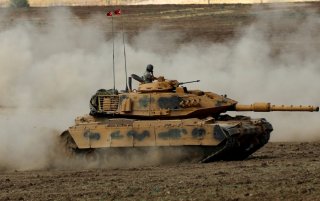Russia Is Angry: Ukraine and Turkey are Building Stronger Defense Ties
Turkish/Ukrainian defense cooperation has stepped up significantly in the past few years, with Turkey building on Ukraine’s strengths of armor and anti-armor technology.
Here's What You Need To Remember: Zaslon is one of the more “crude” hard-kill active protection systems on the market, relying on multiple explosive “tubes” that are normally retracted into the side of a vehicle on which it is being installed. When in a high threat area, the tube is extended, and a radar in the tube is activated, searching for a target.
Turkish/Ukrainian defense cooperation has stepped up significantly in the past few years, with Turkey building on Ukraine’s strengths of armor and anti-armor technology. One of the more interesting results of this collaboration is the installation of the Ukrainian Zaslon active protection system (in a licensed form made by the Turkish Aselsan firm) on Turkish M60 tanks.
Zaslon is one of the more “crude” hard-kill active protection systems on the market, relying on multiple explosive “tubes” that are normally retracted into the side of a vehicle on which it is being installed. When in a high threat area, the tube is extended, and a radar in the tube is activated, searching for a target. When a threat is detected by radar, the tube detonates, creating a wave of debris that destroys or weakens the projectile. Zaslon’s creators say it is effective even against kinetic energy rounds, but this is doubtful.
However, the nature of Zaslon makes it an ideal candidate for retrofitting to existing vehicles. Zaslon doesn’t require an additional turret-mounted radar module, and the Zaslon modules are typically placed on the hull rather than the turret, so additional strain on turret drive (as seen with Trophy on the M1 Abrams) is not imparted. Ukrainian sources also state that Zaslon’s simple “detonate” nature is faster than directed active-protection systems like Trophy, as the “hard kill” countermeasure does not need to turn and aim at a target first.
Of course, Zaslon has the major drawback of being fatal to friendly infantry surrounding a tank, which can pose problems in situations where infantry and tanks work in close cooperation. The US has hesitated to field APS on most tanks for this reason, opting for directed systems. However, this “shotgun” lethality can be a benefit, and there are controls to extend and detonate Zaslon modules as a last-ditch anti-infantry weapon.
Unfortunately, there are no records of Zaslon’s effectiveness when deployed by the Turkish Army on their M-60T tanks during recent offensives. But many tanks that have participated in the offensive are variants of the Leopard 2, which have not been fitted with Zaslon or Zaslon variants, despite assurances that integration was being pursued in 2018.
The Turkish Zaslon variant also differs from the original Zaslon configuration, which holds 2 interceptors. Rather, it is based on the Zaslon-L variant which only holds one interceptor. This makes it very vulnerable to saturation attacks, as once an interceptor is spent that angle of coverage is vulnerable to a follow-up attack. While this may be fine for intercepting single anti-tank guided missiles, it could be a significant drawback in close combat where multiple shots to a single sector may be anticipated.
Charlie Gao studied political and computer science at Grinnell College and is a frequent commentator on defense and national-security issues. This article first appeared in March 2020 and is being republished due to reader interest.
Image: Reuters.

